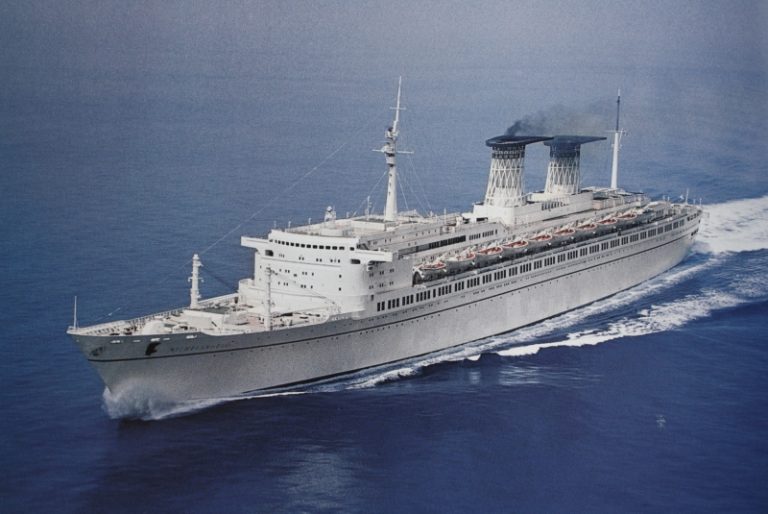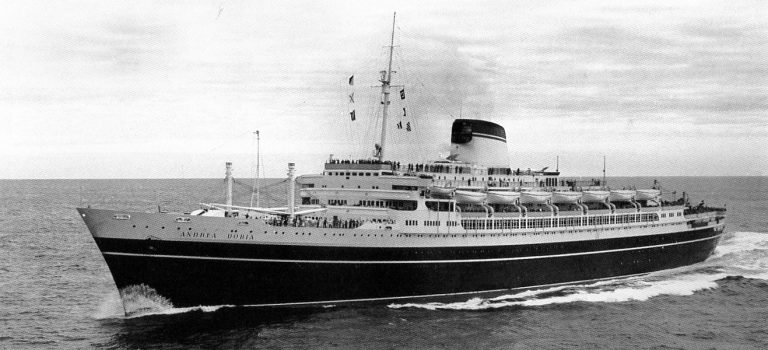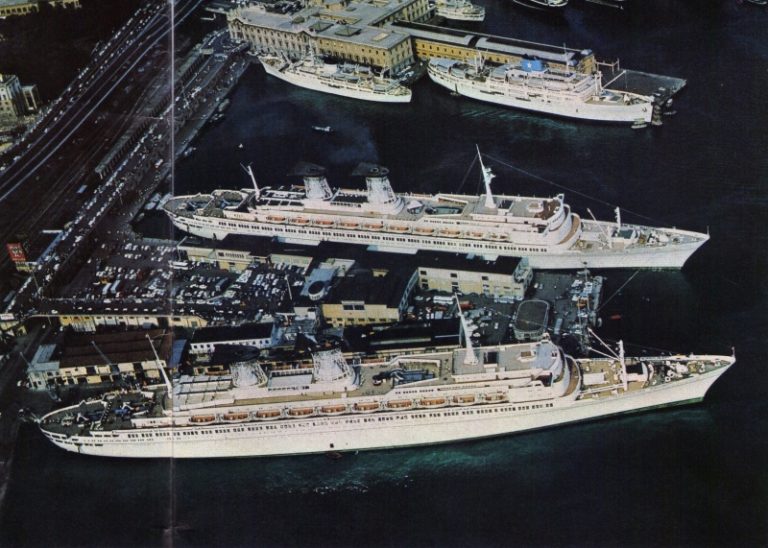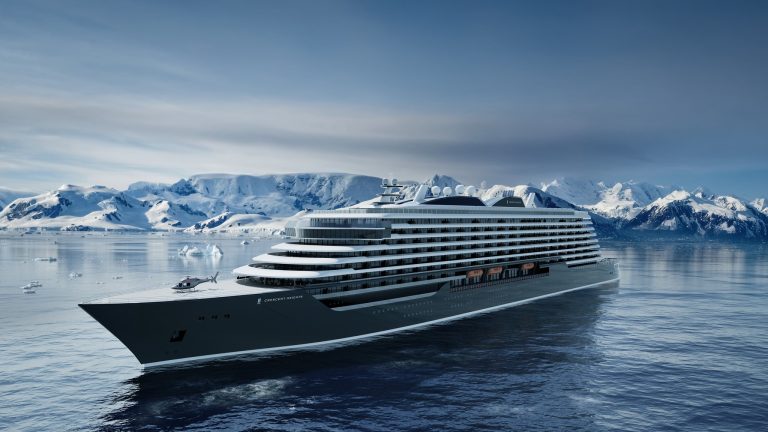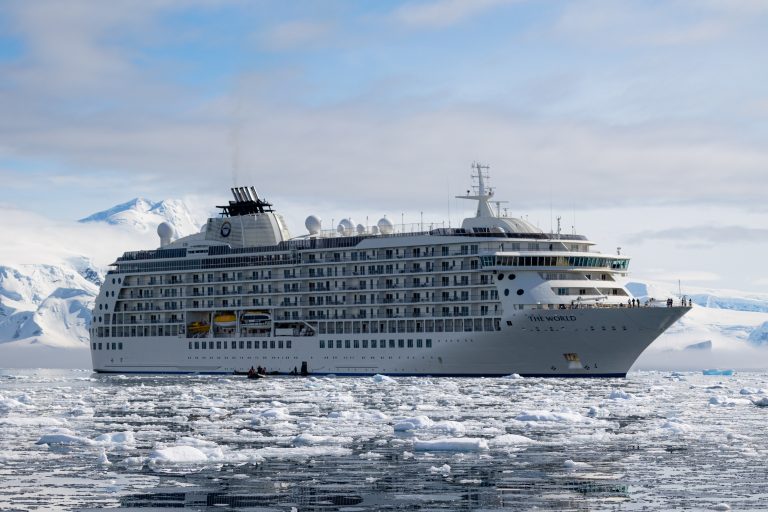From the pinnacle of ocean liners to floating residences
At the beginning of the twentieth century, when the Atlantic still represented a threshold, traveling by sea was not one option among many—it was the very act of crossing worlds.
The great passenger ships were the ultimate symbol of industrial modernity: vast structures of steel and confidence in the future, designed to unite continents through their slow and majestic movement across the water. The ocean was not yet a place to contemplate, but a space to be conquered. Yet, in that crossing—those suspended days between one shore and the other—something began to emerge, something without a name but already powerful: the sense that living at sea, even briefly, transformed time.
The Michelangelo, the last Italian ship to operate a regular transatlantic passenger service.
The Andrea Doria, the famous Italian ocean liner that sank in 1956 following a collision with the Swedish liner Stockholm.
Liners were not designed for pleasure, yet they contained the elements of a refined life. First class embodied the image of a world that sought to feel stable, orderly, secure in its hierarchy. Lounges, libraries, tearooms, and promenades were not mere bourgeois ornaments—they were instruments through which travelers interpreted themselves. The sea, outwardly infinite, became internalized as a mental condition: a slower, longer, more contemplative time. Those in third class lived a different experience—crowded, shared, yet touched by the same suspension. Even in communal dormitories, in the hours of waiting and uncertainty, the ship imposed its own rhythm, a rhythm unlike that of the land. The sea could not be hurried. Time was given—and it was shared.
Then came the jet age, and the world changed swiftly. Distance shrank. Speed became a value. Travel ceased to be lived time and turned into an interval to be minimized. The goal was to arrive, not to cross. In that burst of modernity, it might have seemed that the great liners were destined for memory, for faded photographs and nostalgia. Yet it was precisely at the moment when the ship’s original purpose disappeared that its latent one emerged: a ship’s true worth was not in taking people elsewhere, but in creating a self-contained world—concrete and symbolic at once. The sea could be a place to dwell, not merely to pass through. Suspension could evolve from a transitory condition into a structural form of experience.
From this transformation, the modern cruise was born. The ship was no longer conceived as a means, but as a space. No longer a way to go, but a place to be. The journey no longer required a destination—the destination was the journey. This shift was cultural before it was commercial. The ship was reimagined as a moving city, with districts, spaces for social life, well-being, and shared pleasure. Within this structure emerged the elements that make cruising unique: the ritual repetition of days, the familiar rhythm of faces, the constant interplay between privacy and togetherness, and the sea as a mental landscape.
The Raffaello and her sister ship Michelangelo were the last Italian ocean liners to operate passenger services between Italy and America.
Over time, ships grew—not only in size but in purpose. They introduced theaters, contemplative spaces, specialty restaurants, wellness centers, areas devoted to silence, and spaces designed for celebration. Above all came the private balcony, transforming the relationship between individual and sea. The sea entered the cabin. It became a daily horizon. No longer distant or accessible only from the decks, it became intimate, close, domestic. One sleeps with the sea, dines facing the sea, thinks within the sea. This seemingly simple change radically altered the perception of the ship: no longer a hotel room, but a temporary home; not a tourist structure, but a personal space.
And here begins the transition toward the concept of the floating residence. A quiet question emerges: if one can live well at sea for a week, why not for a month? If for a month, why not a year? And if for a year, why not permanently? The shift is gradual—cultural, experiential—but when it takes form, travel ceases to be travel; it becomes a way of life.
A residential ship is not a long cruise—it is a city in motion. It has residents, not passengers. It has routines, not schedules. Continuity, not interruption. The community on board is not touristic, but social. Faces return, relationships deepen, familiarity grows. The ship develops a rhythm: the same spaces crossed each day, like the streets of a neighborhood, like a piazza where one meets without arranging to. People greet each other in the morning, exchange brief words, notice presences and absences. Within constant motion, a new stability takes shape—different from that on land, yet no less real.
Regent Seven Seas Navigator
Crescent Seas Suite Crescent Seas
The World
This new way of inhabiting reflects the deeper transformations of our time. Home, in the contemporary world, is no longer necessarily fixed. The relationship between work and space has dissolved: one can work anywhere, with connection, time, and discipline. Community is no longer bound only by geography, but by shared intention. Rootedness is no longer immobility—it is inner continuity. In this sense, the ship becomes a cultural laboratory: a living proof that identity can be mobile without being lost, that community can be fluid without being fragile, that time can be slow without being unproductive.
Living at sea reveals that the world is not defined by the places we possess, but by the rhythms we inhabit. Stability is not about standing still, but about finding oneself in movement. Space need not be vast to be alive; distance does not erase connection; travel is not escape, but perspective. Thus, the cruise evolves—from a moment of pleasure to a form of existence; from an interlude to a habitat; from an event to a condition.
What began as a means of crossing oceans has, in little more than a century, become a way of being in the world—not by conquering new lands, but by embracing the sea as a place where life itself can unfold. An ever-receding horizon that can never be fully reached—and for that very reason, turns life into a continuous voyage, without final arrivals, made of days that open and close like waves: slow, deep, infinite.
Don’t miss the latest cruise news, updates, and reviews on Cruising Journal, with photos, videos, and exclusive offers.

